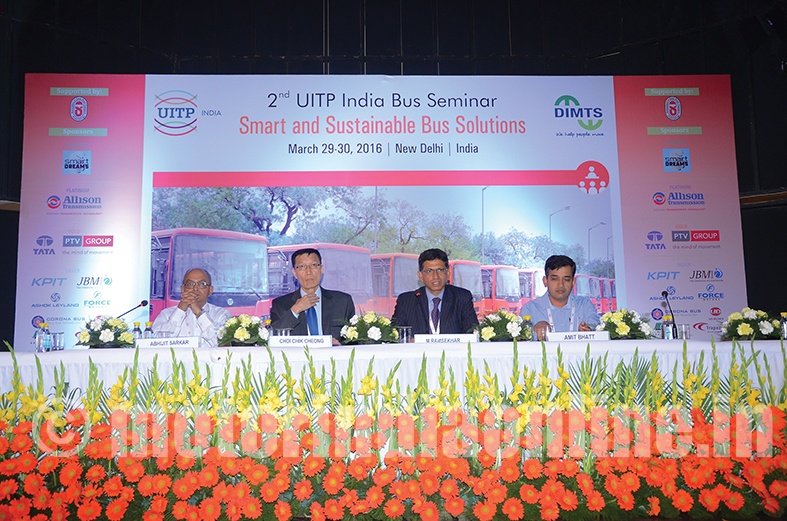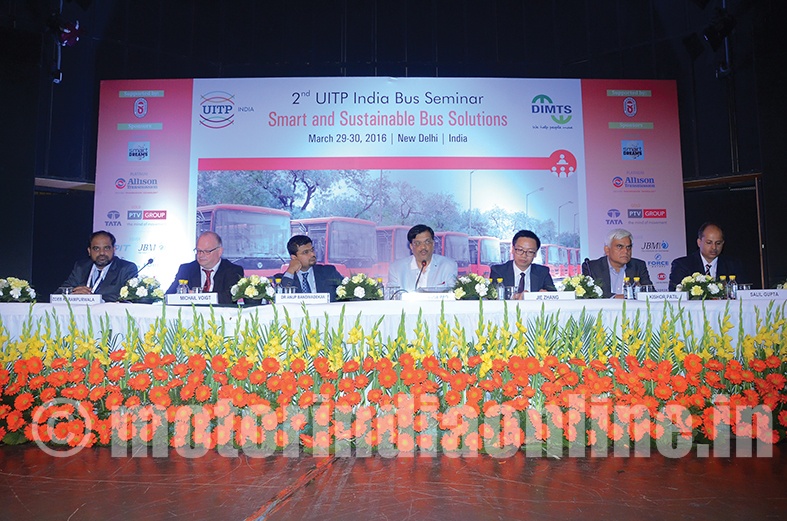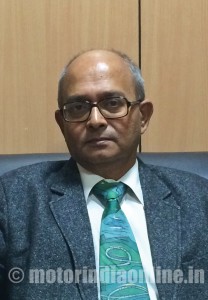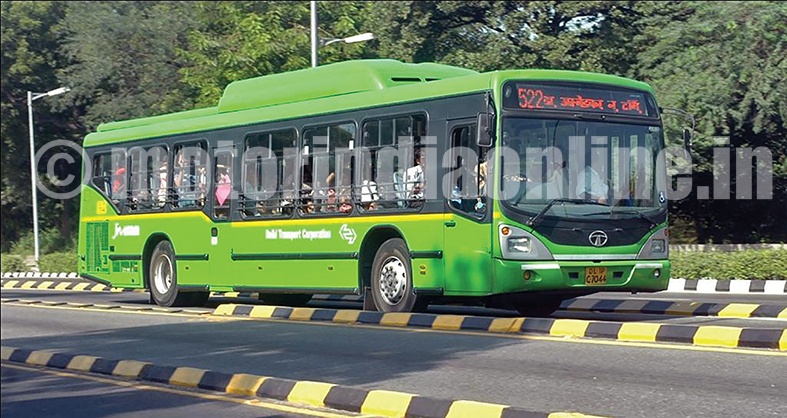The second International Association of Public Transport (UITP) India bus seminar held in New Delhi on March 29-30 in association with Delhi Integrated Multi-Modal Transit System Ltd. (DIMTS) turned out to be a grand success.

The two-day seminar that attracted delegates from across the globe and from different organisations in India, including public transport undertakings, State Government departments and manufacturing industries, explored how buses can improve livability in cities.
While Smart Dreams was the Diamond Sponsor, Allison Transmission was the Platinum Sponsor and the PTV Group and Tata Motors were the Gold Sponsors. The event was also supported by Silver Sponsors such as KPIT, Ashok Leyland, JBM, Trapeze, Corona Bus, UD Buses, MP Group and Force Motors. MOTORINDIA was the exclusive Media Partner for this event. The key objective of the seminar was to promote bus as a preferred mode of transport.
There were four technical sessions on the first day, with domestic and international industry consultants sharing their knowledge and expertise on crucial topics such as policy framework of Public Transportation (PT) bus system, bus contracting model, components for an efficient bus system, new bus technologies, alternative fuel options and the need for adequate transport infrastructure.
Mr. M. Ramsekhar, Executive Director & Joint CEO, DIMTS Ltd., in his opening remarks, said: “Buses are of the least cost, most efficient and flexible modes of transport, and we don’t even give a thought to it. But let me remind you that buses have undergone a big makeover. The segment is witnessing a massive transformation in terms of propulsion technologies, aesthetics, technological interface, etc. With the boom in information technology and mobile telephony, the entire mobility space is witnessing a seismic shift, and buses are playing a central role in this. We have to bring the best practices to the primary stakeholders and collectively engage in some sort of a discussion as to what the best practices the world over are, so that we can transform the bus mode of transport in the country.”

In his address, Mr. R.K. Kataria, Vice President, Association of State Road Transport Undertakings (ASRTU), and Managing Director, Karnataka State Road Transport Undertakings (KSRTC), observed: “Bus, as a mode of transport is an important connecting point. State Transport Undertakings (STUs) roughly own 170,000 buses and carry around seven crore passengers per day, i.e., three times more than the Indian Railways. We cater to the most remote areas in the country. But the key issue is whether we are able to provide adequate and efficient transport facilities in the remote areas of this country. Moreover, there is a shift from private transport to public transport in developed and Asian countries like Singapore, Korea, etc. We have to focus on this shift, and for that we need to find out the missing links.”
Dr. Ekroop Kaur, Chairperson, UITP India Board, and Managing Director, Bangalore Metropolitan Transport Corporation (BMTC), highlighting the achievements of UITP, said: “No matter whatever the mode, buses shall always be the backbone and bulk of the people would continue to use it. So the focus of UITP in India is also on the bus segment and, with ASTRU as a member of UITP, this segment will always get the prominence it deserves. Going forward, we will organize more training programs for buses and metro sectors. We will be bringing in international expertise which will help the members who attend these programs. We can also learn a lot from European countries and implement it here partly if not completely”.
In his keynote address, Mr. K.K. Sharma, Chief Secretary, Government of NCT of Delhi, emphasized that there is a need for appropriate policies to promote buses and public transport overall. “There are 7,000 buses operating in Delhi. These buses carry 2.5 million passengers a day. The Government is planning to induct 3,000 more buses this year, out of which 1,000 buses will be procured by the Delhi Transport Corporation (DTC), 1,000 buses will be inducted under the cluster scheme and 1,000 buses will be inducted under the Premium Bus Service by allowing new players to operate the service.”
Mr. Jerome Pourbaix, Head of Policy and Outreach, UITP Brussels, shared his experiences and advocated investment in public transport. He stated: “The public transport creates value for citizens, businesses and the Government for creating competitive alternative. It contributes to city competitiveness and also vehicular strength of that city. It also creates human capital, global appeal and quality of life. It allows better connectivity and access to productive jobs and has a bigger impact at the macroeconomic level on the economic development of that city. This physical activity due to travel in public transport results in better health, thus there is less expense on public health.”
Mr. Choi Chik Cheong, Deputy Director, Land Transport Authority (LTA), Singapore, spoke on the new contracting model adopted in his country. He shared: “Today the steps that the Government has taken in moving the bus industry in a contracting model is commendable because it will raise bus service standards for commuters and will optimally improve the total journey experience. Likewise, in our country the service standards are regulated by LTA, which has invited bids for the operation of the buses procured. The bids were evaluated on the base of quality and price and the contract awarded to the top bidder.”
The valedictory address was delivered by Mr. Pankaj Kumar, Vice Chairman and Managing Director, Gujarat State Road Transport Corporation (GSRTC).
He said that Ministry of Road Transport & Highways (MoRTH) has formed a group of ministers headed by the Transport Minister of Rajasthan. Other Transport Ministers are also part to prepare action plan for the road sector, with focus on public transport.
He highlighted the importance of strengthening rural bus transport to create better economic opportunity, as well as to reduce migration from rural to urban areas. He also emphasized that Urban Transport has to be an essential ingredient of urban planning.
Most of the speakers were unanimous in their views that there is a change required in the public transport sector to make it more attractive and competitive vis-a-vis other personalized modes in the mobility market. There was a consensus reached that the PT stakeholders need to respond to citizen’s expectations by increasing investment in the development of new services and facilities and by streamlining the existing network by putting the customers in the centre of a corporate strategy. On the second day, UITP also organized a technical visit to DIMTS Operation Control Centre (OCC) for the participants. Around 30 delegates got an opportunity to see the electric bus developed by CIRT and KPIT.
The bottomline is that the rapid pace of urbanization and the economic growth in India has resulted in growing in an increase in travel demand. Difficulty to control and coordinate land use and transport planning and the growing middle class has led to a tremendous increase in the number of personalized vehicles. Mobility needs to be rapidly changed in order to avoid the adverse effects of uncontrolled urban and mobility growth. Public transport provides safe, sustainable and cost-effective mobility. It has to become the preferred choice of everyone by developing the system by adopting urban mobility planning and suitable integration.
All-out bid to make Delhi-NCR public transportation customer-friendly
MOTORINDIA caught up with Mr. Abhijit Sarkar, Chief (Road Transport), Delhi Integrated Multi-Modal Transit System Ltd. (DIMTS), wherein he stated that, apart from making Delhi pedestrian-friendly, there has to be a dedicated lane for buses which will ensure revival of public transport in the city.
Excerpts:
This is the second time that UITP has organised its seminar on Bus Transportation. What are the key takeaways from this?
The key takeaways are that people need to have very friendly modes of transport and have to be able to move from one place to another safely and conveniently. Dependence on personal vehicles like cars has to be reduced considerably in the country because of the pollution that is caused, apart from the costs involved. The city’s infrastructure also has to be people friendly. Amenities like footpath at grade and proper walking facility, which are very elementary, should be provided. They make a world of difference to the quality of life of the commuters. If you have adequate footpaths and can reclaim some pedestrian space from motorized vehicles, bus transportation will get a massive push. Researchers have come out with studies which have maintained that you cannot keep providing space for all the vehicular traffic that will be there. Statistically speaking, Delhi has one of its highest areas with roads at 20%. This is more than at Paris 13% and London at 14-15%. There is a common perception that building flyovers will ease off the traffic congestion and vehicles will travel at a great speed. But it ends up clogging the entire space. The ideal way would be reallocation of space to emergency vehicles, fire tenders, police vehicles and buses.
In your view, how has the progress been on improving urban transportation by the Government?
Even though there has been some fair progress in terms of acquisition of buses, enough attention has not been paid to the quality of service, commuter orientation, etc. Moreover, the quality of public transport provisioning will improve with a lot of other things that happen in the environment. For example, the way bus stops are designed it is very difficult for a bus driver to dock at a bus stop. This typically happens when buses are set back from the main carriageway as in highways. There are places where vehicles like autorickshaws are parked next to the bus shelter. I also find people stepping off the pavement and standing on the road. Of course, there has been some progress in the IT space as it is being adopted to facilitate commuter movement and improve the functioning of fleets and operating organisations. There is definitely some interest generated among State transport undertakings to revive its operations. They are now increasingly concerned about stronger commuter-focused service. One of the presenters at the conference very rightly said that it is not only urban mobility or transport, but there should be an equal focus on public transport, mobility and access to mofussil towns and on connecting rural areas.
What are the key steps that we should take to make Delhi-NCR’s public transportation one of the best in the country?
One of the three key steps would be building safety into design. That can be done if the Government builds intelligently designed, at grade (on ground level) network of footpaths. This should be supported by proper and convenient walking facility. There should also be a lot more signalized junctions in places where there are free left turns and where people can cross the road without any hassles. I think that will make the pedestrians’ life a bit easy and will dramatically improve the transport scenario. The second most important step is to have dedicated lanes for emergency vehicles and buses. That will also improve the turnaround time of buses. That makes the lives of a larger number of commuters easier.
Another step that can be taken is densifying certain places to encourage a move away from ‘Street Urban Zoning’. For example, if a person needs to visit a nearby shopping district, school or any facility within a striking distance, he may not have to resort to personal vehicles. So walking or cycling should be encouraged in such scenarios. This is because there is often a fallacy involved in how large parks and green spaces are the lungs of the city. The basic issue that we need to address is the last-mile connectivity which is either done on foot or by cars.
Do you think there should be vestibule buses to cater to routes where the number of commuters is high?
It all depends on how much the authorities are ready to invest. If you have to invest on buses which are not rush loaded, there has to be an investment so that the buses are far more frequent. So vestibule buses can easily run in busy cities like Delhi and will eventually be added to the fleet.
It is a known fact that BRT didn’t click too well in Delhi. So what is the way forward?
The way forward is to build them and run them. It is a call that the public authorities needs to take. They have to decide on a strategy on how it can happen. It is far better known to them and I am in no position to make a prescription. What I can only say is that there has to be a systematic public information, and there has to be ownership. There has to be more public awareness too.
There have been a lot of discussions on hybrid and electric vehicles with many OEMs coming out with interesting vehicles and solutions. How can we use different fuel options to create a robust public transport system?
I don’t feel very comfortable with a wide mix of fuel options. The biggest trouble is of creating a supply and distribution network. I think electric vehicles are the future because in Delhi we cannot have diesel hybrid buses. We can have CNG-driven hybrid vehicles. But some fleets can of course run on biodiesel that can be produced by processing of solid waste.
Lastly, can you throw some light on the role played by DIMTS in improving urban transportation in the NCR region? What are your plans and targets for the next few years?
We work as consultants to our clients with many of them from the governmental authorities. So we give them inputs on strategies that they can implement and provide solutions that they can adopt for a particular urban situation or transportation situation. We handhold them and step in where the Government for understandable reasons may not have the resources available in terms of professionals. This is because it is not so easy to take on board a professional and then tell him to leave. Since they don’t have that flexibility, we pitch in with our expertise. Moreover, we have a very strong public focus, and we won’t do anything just because we have the money to spend. Our one major target is to try and see if our experience in the field of operations of buses and transportation planning can be taken to many places. For example, we are working with 14 Indian States on different projects. We are also working on a few overseas projects, with five of them already finalized.

